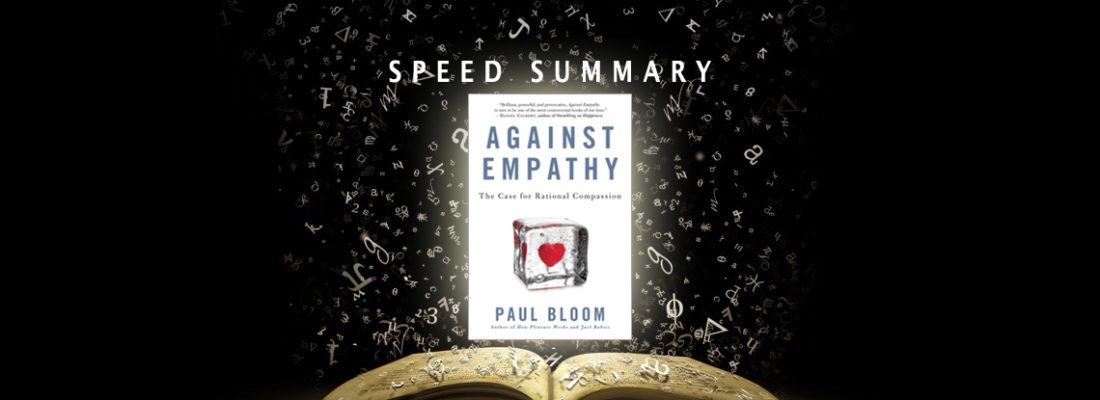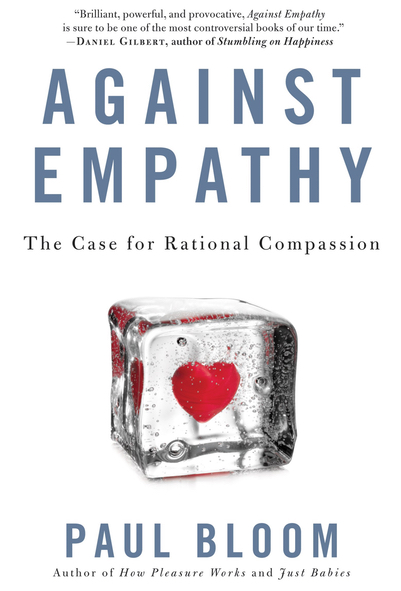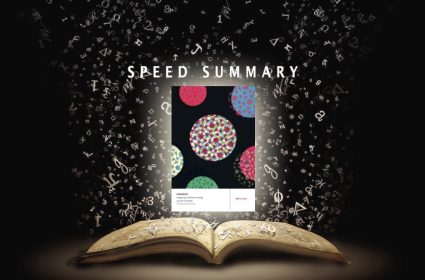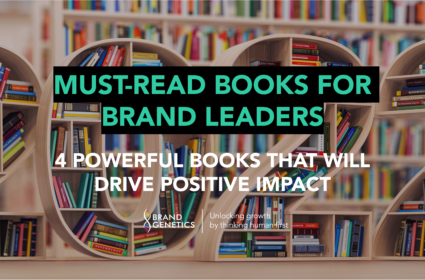Speed Summary: Against Empathy – The Case for Rational Compassion


- Against Empathy: The Case for Rational Compassion
- Author: Paul Bloom
- Publisher: Ecco
- Publication: 2017
Are you a good “mindreader”? Empathy techniques for reading the minds of consumers are becoming increasingly popular in insight, innovation, and design.
Despite supernatural overtones, mindreading is perfectly natural and one of two defining characteristics of the human capacity for ‘empathy’ (a term coined a century ago from the German Einfühlung for what Adam Smith had called “fellow feeling”). Mindreading is what psychologists today call our capacity to put ourselves in the shoes of the other and see the world from their perspective. Some people are more gifted at mindreading than others (there’s a free scientific self-test here). When mindreading is combined with emotional mirroring (feeling what the other is feeling), we experience empathy – seeing and feeling the world from the perspective of the other.
Empathy = Mindreading + Emotional Mirroring
Shoe-shifting
In business, empathy techniques are used to “shoe-shift” into the shoes of the consumer to reveal insights and opportunities that may be invisible in data patterns, interviews, surveys and observation (examples of empathy techniques include immersion, participant observation, co-creation, role-playing, accompanied shops, usability testing, and reflective exercises (e.g. writing a letter to the brand from your consumer’s perspective)). You don’t need an fMRI scanner to read a mind, you just need to bring your own mind and an empathy technique.
As a concept, empathy has good pedigree – ex-President Obama famously noted that “the biggest deficit that we have in our society and in the world right now is an empathy deficit.” With 80% of brand managers believing that the brand they sell is the best on the market and only 8% of those consuming their brand actually agreeing, it’s hard to disagree. In business, Henry Ford claimed “If there is any one secret of success, it lies in the ability to get the other person’s point of view and see things from his angle”. And eminent psychologist Simon Baron-Cohen (yes, cousin of comedian Sacha) has convincingly argued that the absence of empathy may be the root cause of evil today, and like Obama, he worries about widespread ’empathy-erosion’ – as we lose the willingness and ability to shoe-shift and see and feel the world from the other people’s perspectives.
Enter Paul Bloom, influential Yale psychologist and TED Talk ‘millionaire’, and his latest book ‘Against Empathy’ in which he wages a self-declared “anti-empathy crusade”. Bloom argues with evidence, conviction and logic that empathy is bad for you – and us. Empathy, he argues is biased, myopic, and innumerate – often leading to bad decisions, prejudice and dysfunctional behaviour.
In six chapters and two ‘interludes’ Against Empathy seeks to cull the sacred cow of empathy with five key evidence-based arguments. But first, Bloom clarifies what empathy is and isn’t. When you feel concern or compassion for someone (e.g. your consumer), that’s not empathy, it’s sympathy. But when you feel (and understand) what they are feeling, that’s empathy. In short; sympathy = “feeling for”, empathy = “feeling with” (e.g. ’I feel your pain’). Bloom also notes that empathy appears to be a whole-brain phenomenon – using affective and cognitive processing – there is no empathy module for mind reading and emotional mirroring.
So why is empathy bad for us? Surely seeing and feeling the world from the consumer perspective should be a good thing? Well no, apparently.
- Firstly, empathy induces us to identify with the situation, task or challenge of a single person; you can’t shoe-shift into the shoes of multiple people – let alone an entire target market. Seeing and feeling the world from the perspective and feelings of one person will be as biased, partial and personal as your own personal perspective. Bloom shows how this can play out perversely in the allocation of resources – empathy means we can be transfixed by the plight of a single baby girl stuck in a well (Jessica McClure, Texas, 1987) or missing (Madeleine McCann, 2007), but indifferent to thousands of faceless and preventable deaths. This is known as the “identifiable victim effect” – and in business when we bring to life the the pain or frustration of a particular consumer – we are moved to alleviate their problem, even if this is not our best allocation of limited resources. The upshot is that empathy is innumerate, inciting us to focus on the plight of an individual, sometimes at the cost to the many.
- Secondly, because shoe-shifting requires stepping into the shoes of someone else, empathy can be blind to concerns of future generations who don’t yet have shoes – such as those who may suffer from the consequences of global warming. More generally, empathy leads to the overrating of present costs and benefits and to the underrating of future costs and benefits. This means empathy is not only innumerate, it is also myopic.
- Thirdly, the people we chose to feel empathy tend to reflect our own biases, prejudices and parochial concerns. We find it easy to feel empathy for people we identify with; our neighbours and people like us, but it’s more difficult with strangers. This can make empathy innumerate, myopic and prejudiced.
- Fourthly, empathy can be exploited and used to incite an emotional rather than rational response ; feeling the pain or injustice of another can motivate an emotional, irrational – and even sometimes violent response. Think media images and ‘human interest’ stories of a particular individual’s plight used to justify war or incite anti-immigrations sentiment. Empathy can be innumerate, myopic, biased and overly emotional.
- Fifthly, whilst empathy can – and does – promote caring, altruism and pro-social business, it can also render our altruistic acts less effective. This is because empathic action is guided by emotional impact, rather than the material impact of what we do. For example, CSR initiatives involving many charities may be emotionally rewarding (helping lots of different people), but processing costs make scattergun CSR less effective than partnering with a single cause. Moreover, there can be a selfish dimension to empathic care; when we feel the pain or frustration of our consumer – we act to reduce our own pain or frustration that we experience vicariously – rather than out of care for the consumer. So not only is empathy innumerate, myopic, biased, emotional, empathy can be ineffective and sometimes selfish as well.
Against Empathy ends with the conclusion that empathy is a thoroughly bad compass for making choices and informing decisions, particularly those with a moral dimension. What Bloom suggests we should do is jettison empathy altogether, and replace it with what he dubs “rational compassion”. Rational compassion involves a objective, logical analysis of costs and benefits, with a sympathetic but detached and dispassionate concern for the wellbeing of others. Only by removing our emotional involvement with consumers can we make rational decisions about how to best meet their needs.
The Brand Genetics Take
For fans of empathy techniques in identifying business opportunities, Against Empathy is a curiously compelling read. Bloom identifies real weaknesses in being an “Empath”, and we need to be aware of these limitations. But in a world of Big Data, where decisions are increasingly de-humanised and informed by spreadsheets rather than people, do we really want to emulate AI, algorithms and robots? We can’t out-AI AI, but what we can do is play to our human strengths and become more human, more empathic and in doing so see what AI can’t (yet) – the experiential and emotional reality of our fellow humans. Empathy has the power to make the experience of others observable and salient to us, and in doing so empathy can reveal opportunities that may be invisible to algorithmic logic.
To be fair, Bloom is not always against empathy, he just wants less of it involved in our decisions – particularly those of a moral kind. But by focusing on the affective – emotional – dimension of empathy rather than the cognitive – perspective-taking – dimension, Bloom creates an empathic straw man. Cognitive empathy is part of our social intelligence, and perspective-taking may even be pre-requisite to collaboration and cooperation. The two facets of empathy – cognitive and affective – work together and are like two halves of an archway, each supporting each other to see the world through an arched doorway from the perspective of the other; without both sides of the arch, the doorway collapses and there is nothing to see. Quantitative analysts are keen on the quip “in God we trust, all others bring data”, but as card carrying Empaths, we’re with Henry Ford on this – in humans we trust, because we bring empathy.




